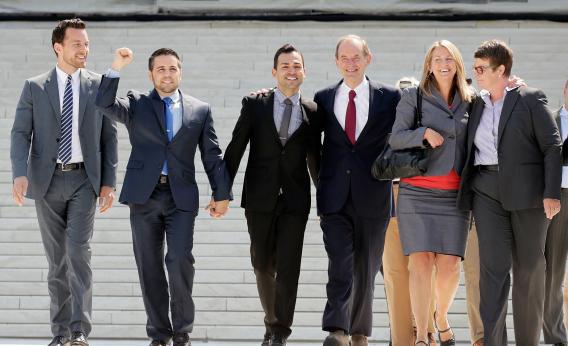The U.S. Supreme Court struck down the Defense of Marriage Act on Wednesday and let stand a lower court decision that reinstituted gay marriage in California. Historians have referred to the cases as Brown v. Board of Education for gay rights. Was the public this fixated on the Brown decision in 1954?
Probably more so. Public anticipation of the gay marriage decisions has been intense. Journalists, activists, and ordinary citizens have swarmed the court steps for days, and news outlets have treated this week’s rulings on affirmative action and the Voting Rights Act almost as appetizers leading up to the gay marriage ruling. But a similar thing happened in 1954. Crowds packed the Supreme Court every decision Monday for weeks. The New York Times assigned 50 reporters to cover the case. When the justices ordered the integration of juries two weeks before the Brown case came down, journalists scoured the decision for clues on how the court would treat school segregation. Brown v. Board of Education may not have dominated front pages in the way that gay marriage likely will, but that’s because the decision came down in the heart of the Army-McCarthy hearings, which were nationally televised and hastened the downfall of legendary Sen. Joseph McCarthy.
The significance of the Brown decision was so widely recognized in 1954 that the Supreme Court’s press information officer viewed decision day as an irresistible opportunity to prank the press. First, the assembled reporters were told “it looked like a quiet day” at the court. The press officer then announced three low-profile opinions and pulled on his coat. As he strolled out of the room, he casually mentioned, “Reading of the segregation decisions is about to begin in the courtroom.” (The consolidated segregation cases didn’t become popularly known as Brown v. Board until years later.) The reporters stampeded up a flight of marble stairs and burst into the courtroom, where Chief Justice Earl Warren had already begun reading the opinion. The Times noted that the solemn-faced justices “obviously were aware that no court since the Dred Scott decision … had ruled on so vital an issue in the field of racial relations.”
A few factors separate Brown from Wednesday’s gay marriage cases in terms of significance. In striking down the Defense of Marriage Act and allowing gay marriage to return to California, the justices avoided the larger question of whether the Constitution guarantees the right to gay marriage. The court’s restraint on this issue is typical of modern jurisprudence. The Supreme Court was different in 1954. In Brown, the justices went further than many people anticipated. Southern governments expected the Supreme Court to accept the premise of separate but equal, as long as separate truly was equal. To demonstrate their bonafides, legislatures in segregated states passed legislation after the Brown oral arguments to improve conditions at African-American schools. If the justices did the unthinkable, outlawing segregation entirely, a few states vowed to abolish their public school systems and turn to a system of vouchers.
That raises another difference between gay marriage and desegregation: There is a widespread belief today that demographic changes will soon make gay marriage legal in much of the country, with or without the Supreme Court’s help. There was no such sense of inevitability over desegregation in 1954. The Warren court took on the segregationists, who ruled much of the South, without the cover of fast-growing public support. Georgia Gov. Herman Talmadge claimed that the Supreme Court had “thrown down the gauntlet” in Brown, promising a fight over the future of schools in the South.
In a sense, the Georgia governor’s statement was prescient. Brown didn’t represent the end of an argument—the role the justices have now become accustomed to playing on issues of equality—but rather the beginning of a decades-long struggle. There is, in contrast, a sense of finality in the gay marriage cases. There are no serious politicians today vowing civil disobedience or armed rebellion to resist the advent of gay marriage.
Got a question about today’s news? Ask the Explainer.
Explainer thanks Michael J. Klarman of Harvard Law School, author of From Jim Crow to Civil Rights: The Supreme Court and the Struggle for Racial Equality.
Read more from Slate’s coverage of gay marriage cases at the Supreme Court.
